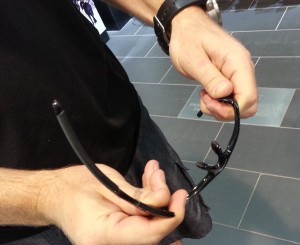Oakley Lenses for Trail and Road
 The email came out of the blue: “Running shoes aren’t the only thing necessary for running,” it read. “It’s important for runners to also protect their eyes with quality, high-performance, activity-specific sunglasses. Avid runners need quality gear.”
The email came out of the blue: “Running shoes aren’t the only thing necessary for running,” it read. “It’s important for runners to also protect their eyes with quality, high-performance, activity-specific sunglasses. Avid runners need quality gear.”
We get this kind of email from time to time, and generally ignore them. But this time, the email came from Oakley.
I have to admit I was an easy mark, as I’ve been a big fan of Oakley sunglasses for many years and already own three different pairs. I’ve long used them because the optics are fantastically sharp and the frames fit my face. They also don’t slide down my nose when I run.
My old friend Richie played an important part in my enthusiasm for eye protection and quality lenses. It started in the summer of 1974 when Richie got a Wrist Rocket slingshot for his birthday. When we weren’t busy terrorizing (but never successfully hitting) squirrels throughout the neighborhood, we were busy using it to break things.
One particular afternoon, we’d collected some soda bottles and put them in a cardboard box to catch the broken glass. I stood about 25 feet away, drew back, and fired a marble from the slingshot at a Coke bottle. It was a perfect shot and the marble hit dead-center on the shoulder of the bottle. I watched in disbelief as the bottle shattered into thousands of tiny pieces while the marble ricocheted straight back and knocked the left lens out of my eyeglasses.
I owe the vision in my left eye to the shatterproof glass of those funky old spectacles.
Many years later, while Richie and I were working on the shambles of a house he’d bought in Rocklin, he handed me his latest pair of sunglasses. “Check these out. They are amazing,” he said. “I cannot tolerate cheap sunglasses.”
He was right. The glasses were amazing. The lenses were sharp and distortion free. And from that point on, I too was unable to tolerate cheap sunglasses.
Essentially, there are two different economic models for sunglasses: either invest in high-quality glasses and take care of them, or get cheap ones and replace them frequently. I would argue that you really have to include the quality of your experience in this calculation.
Fortunately for me, probably because I wore eyeglasses from an early age, I’m able to take care of my sunglasses and keep them around for several years. In fact, I am still using the Half Jacket frames from my first Oakleys purchased around 2000.
Last month, I went to the Oakley store in Arden Fair Mall and met with the manager Brandon, who set me up with two pairs of lenses for my Flak Jacket frames: one for trails, the “VR28,” and one for road running, the “00 Red Iridium Polarized.”
I had just replaced a set of scratched lenses, buying them online based on my assumption of what would be best for me (Gray Polarized). What Brandon told me was I should have gone to him first and had them help me to pick out some that were most appropriate for my needs. Oakley sees this service as a big part of their value. (The store has a zillion lens/frame combinations to select from.)
Both lenses Brandon picked out for me were high-contrast, lenses with a pinkish tint. I would never have picked these by myself, but the packaging does says “Trail” and “Road” right on it.
He also showed me how to swap the lenses out in my frames and reassured me that I wouldn’t break them.
First impression:
The lenses are pretty similar except the road lenses are mirrored, polarized, and slightly darker. The optics are super sharp and distortion free. The pinkish tint gives everything a warm, pleasant tone and the polarizing lenses are especially restful on the eyes.
The Road 00 Red Iridium Polarized lenses cut the glare off the pavement and keep details sharp without making everything too dark. It’s kind of like the lighting you get when it’s somewhat overcast–not dark but glare is greatly reduced and colors and details seem to stand out.
My first run in the road lenses was a regular lunch-time run on a warm and sunny day. My friends were giving me crap about talking endlessly about the glasses, so I had them put them on. Everyone who tried them agreed they were terrific.
The Trail VR28 lenses have a similar tint but are a little less dark than the road lenses, and not mirrored or polarized. I took them out for a spin on the Willow Hills cross country course, where I could see how they managed dappled light on a trail. They are also very nice.
What really sets both of these apart from my gray lenses is the way details “pop.” I guess that’s the high-contrast feature of the lenses.
Longer view:
I’ve run for a few hundred miles in the road lenses and am completely spoiled by them. I already owned the grey polarized lenses and like them fine, but I much prefer the OO Red Iridium lenses for road running. I highly recommend these lenses.
I’ve run a bit less (20 or 30 miles) while wearing the the trail VR28 lenses and they are significantly better for trail running than the plain gray tint I had been running in.
With these trail specific lenses, it’s easier to pick out rocks and roots while rocketing down a twisty single track. I do still find myself pushing my glasses on top of my head while running in deep shade, but I’m not sure if this is a solvable problem.
If you can afford both, get both. If you have to pick one of them, for more overall use (road and trail) and general happiness, I’d go for the OO Red Iridium. It’s a terrific lens for running.
But don’t take my word for it. As mentioned earlier, Oakley wants you to go into their store and put them to work selecting the right frame and lenses for your particular needs.



